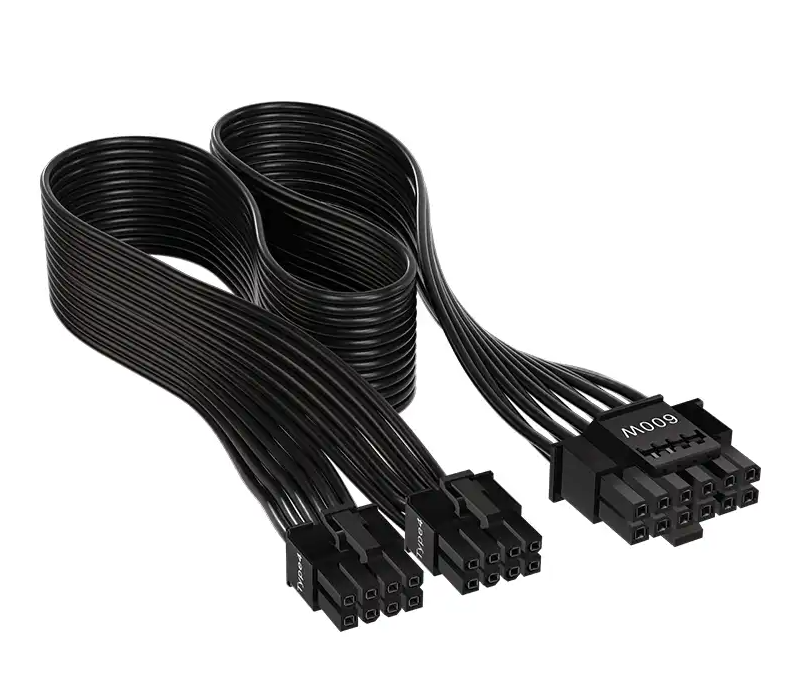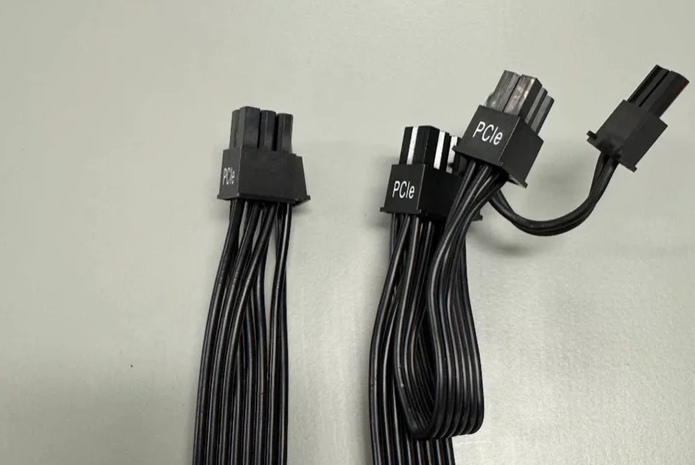The 16-pin power connector (commonly referred to as the 12VHPWR connector in the context of PCIe 5.0) offers several significant advantages over the traditional 8-pin PCIe power connector, particularly designed to meet the demands of high-performance modern GPUs. Here’s a detailed breakdown of its key benefits:

The most critical advantage is drastically increased power output. A single 16-pin connector can supply up to 600 watts of power (12V DC, with 5 pins dedicated to power delivery, each supporting 9.2A), whereas an 8-pin connector is limited to 150 watts (12V DC, 3.3A per pin, with 3 power pins). Even when using two 8-pin connectors (a common setup for high-end GPUs), the combined output tops out at 300 watts—half of what a single 16-pin connector can provide. This massive upgrade is essential for next-generation GPUs like NVIDIA’s RTX 40-series or AMD’s RDNA 3+ cards, which require upwards of 450W to 600W for peak performance, including features like overclocking, ray tracing, and AI acceleration.
By eliminating the need for multiple 8-pin connectors, the 16-pin design simplifies power delivery for manufacturers and ensures stable, consistent power to prevent thermal throttling or unexpected shutdowns during intensive workloads.
The 16-pin connector is more space-efficient despite its higher power capacity. It uses a smaller physical footprint than multiple 8-pin connectors, reducing cable clutter in the PC case. This compact design is achieved through a denser pin arrangement and advanced engineering: 12 of the 16 pins are dedicated to ground (for stable voltage return), while 4 carry the 12V power (plus one keying pin to prevent misalignment). In contrast, 8-pin connectors use 3 power pins, 3 ground pins, and 2 sense pins, requiring bulkier cabling when multiple connectors are needed.
The streamlined design also improves cable management and airflow inside the case, which is crucial for maintaining optimal temperatures in high-end builds. Fewer cables mean less obstruction to cooling fans, helping to keep both the GPU and CPU cooler under load.
Safety is a key focus of the 16-pin connector’s design. It incorporates:
Improved thermal management: The connector and cable are engineered to handle higher currents with minimal resistance, reducing heat generation. Pin contacts use better materials (e.g., gold-plated terminals) for lower impedance and more reliable connections, minimizing the risk of arcing or melting—an issue occasionally reported with 8-pin connectors under extreme loads (especially when using adapter cables).
Secure locking mechanism: The 16-pin connector features a latch that clicks firmly into place, ensuring a tighter, vibration-resistant connection compared to the sometimes finicky retention clips on 8-pin connectors. This prevents accidental disconnection during system movement or heavy GPU stress.
Standardized power signaling: The 16-pin connector follows the PCIe 5.0 specification’s 12VHPWR (12V High Power Wide Range) standard, which includes built-in communication between the power supply and GPU to monitor voltage and current in real time. This allows for dynamic power adjustment and early detection of faults, enhancing overall system stability.
As GPUs continue to evolve with more cores, higher clock speeds, and advanced technologies like HBM (High Bandwidth Memory), power requirements will only increase. The 16-pin connector is future-proofed for these demands, supporting not just current 600W GPUs but potentially higher power limits in upcoming generations (specifications may allow for up to 660W with extended load conditions). In contrast, 8-pin connectors are inherently limited by their design, forcing manufacturers to rely on parallel connections or auxiliary power solutions that lack the elegance and safety of a single, high-capacity connector.
Additionally, using a 16-pin connector future-proofs your PC build: if you upgrade to a newer, more power-hungry GPU in the coming years, a compatible power supply with native 16-pin outputs will eliminate the need for adapters (which can introduce reliability risks) and ensure full support for the card’s capabilities.
While modern high-end GPUs (e.g., RTX 4090) often include an adapter from 16-pin to three 8-pin connectors for backward compatibility, native 16-pin support in power supplies (typically labeled as “PCIe 5.0 ready”) offers a cleaner setup. A single cable from the PSU to the GPU replaces multiple 8-pin cables, reducing installation complexity and the chance of human error (e.g., partially inserted 8-pin connectors, which can cause overheating).
For users building new systems, choosing a PSU with 16-pin connectors ensures seamless compatibility with the latest GPUs without relying on adapters, which are often temporary solutions and may not meet the same safety or performance standards as native cables.
While 16-pin connectors are ideal for high-end GPUs, 8-pin connectors remain sufficient for mid-range or older GPUs (e.g., RTX 3070 or lower, AMD RX 6000 series and below), which typically draw under 300W. Upgrading to a 16-pin setup only becomes necessary when using power-hungry flagship GPUs or planning for future hardware that requires the higher power ceiling.

The 16-pin power connector represents a pivotal upgrade for high-performance GPUs, addressing the growing need for reliable, high-power delivery in a compact, safe, and future-ready package. Its advantages over 8-pin connectors—higher wattage, efficient design, enhanced safety, and future-proofing—make it essential for anyone using or planning to use top-tier graphics cards. As the industry shifts toward PCIe 5.0 and beyond, the 16-pin connector is a foundational component for maximizing GPU performance while ensuring long-term system reliability.